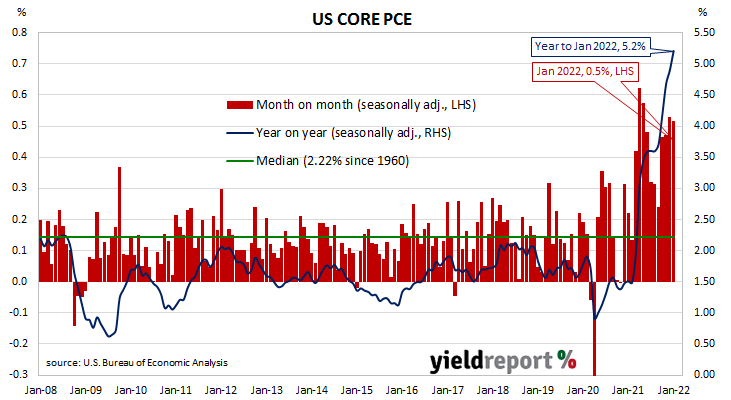Summary: US Fed’s favoured inflation measure up 0.5% in January; in line with expectations; annual rate accelerates from 4.9% to 5.2%; indicates a “broadening of inflation pressures”, highest core reading since April 1983; Treasury bond yields hardly move, rate rises firm up.
One of the US Fed’s favoured measures of inflation is the change in the core personal consumption expenditures (PCE) price index. After hitting the Fed’s target at the time of 2.0% in mid-2018, the annual rate then hovered in a range between 1.8% and 2.0% before it eased back to a range between 1.5% and 1.8% through 2019. It then plummeted below 1.0% in April 2020 before rising back to around 1.5% in the September quarter of that year. It has since ran up well above 3% during 2021.
The latest figures have now been published by the Bureau of Economic Analysis as part of the January personal income and expenditures report. Core PCE prices rose by 0.5% over the month, in line with expectations as well as December’s increase. On a 12-month basis, the core PCE inflation rate accelerated from December’s 4.9% to 5.2%.
ANZ Head of Australian Economics David Plank said the report indicated “a broadening of inflation pressures” and noted core PCE had not been this high since April 1983. “Russia’s invasion of Ukraine is likely to add to global food price inflation, already rampant,” he added.
US Treasury bond yields barely moved on the day. By the close of business, 2-year and 10-year Treasury bond yields had both returned to their respective starting points at 1.57% and 1.97% while the 30-year yield finished 1bp lower at 2.28%.
In terms of US Fed policy, expectations of a higher federal funds rate over the next 12 months firmed up. At the close of business, March contracts implied an effective federal funds rate of 0.24%, 16bps higher than the current spot rate. June contracts implied a rate of 0.825% while March 2023 futures contracts implied an effective federal funds rate of 1.825%, 175bps above the spot rate.
The core version of PCE strips out energy and food components, which are volatile from month to month, in an attempt to identify the prevailing trend. It is not the only measure of inflation used by the Fed; the Fed also tracks the Consumer Price Index (CPI) and the Producer Price Index (PPI) from the Department of Labor. However, it is the one measure which is most often referred to in FOMC minutes.


